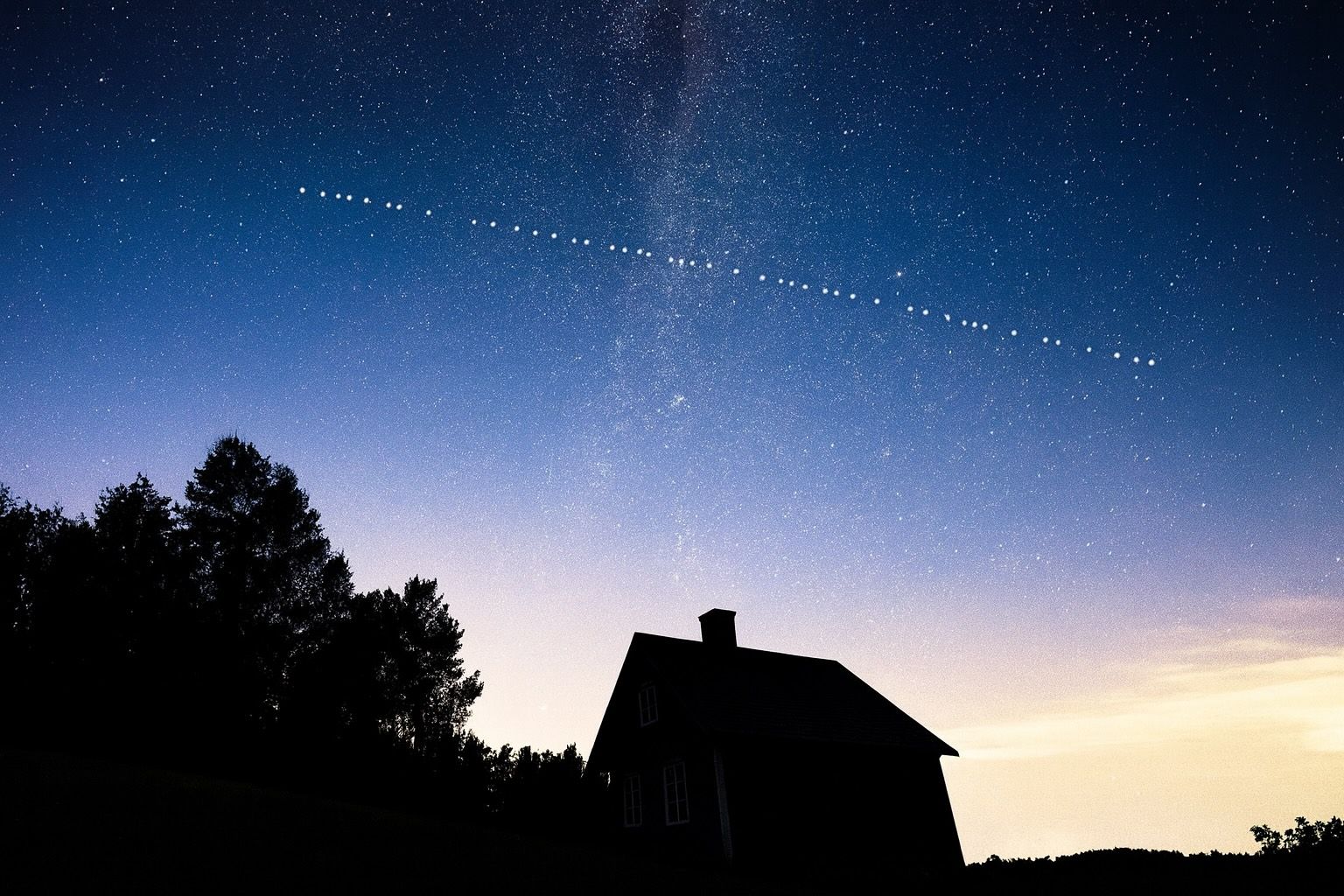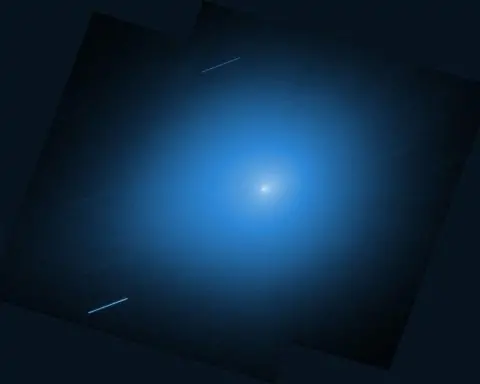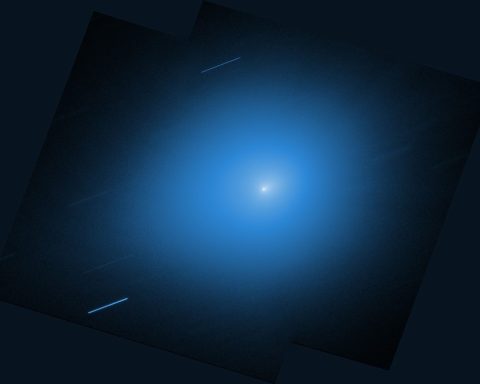- As of August 2025, there are over 8,000 Starlink satellites in orbit, with about 8,075 currently functioning and accounting for roughly 65% of all active satellites.
- Starlink satellites orbit at roughly 550 km (340 miles) altitude and are launched in batches of 50+ on SpaceX Falcon 9 rockets, with each satellite weighing 260–800 kg depending on version.
- They are visible because they reflect sunlight, best seen in the hour after sunset or before sunrise when the sun is 10–30 degrees below the horizon, appearing as a moving train of lights.
- Early satellites were extremely bright, leading SpaceX to test DarkSat coatings and later add VisorSat sun visors; since mid-2020 nearly all new satellites have anti-reflective treatment.
- After launch, a newly deployed batch appears as a bright train of 20–60 satellites in a tight formation for 1–5 days before dispersing to their final orbits.
- The satellites travel about 27,000 km/hour and complete an orbit every 90 minutes, so if you miss one pass another may occur about 1.5 hours later.
- A 2022 American Astronomical Society report warned the proliferation could double night-sky brightness, and the IAU issued a 2019 statement urging mitigation.
- Brightness often exceeds magnitude 6, with many satellites brighter than magnitude 7, though right after launch they can reach magnitudes around 2–3.
- In January 2025 SpaceX voluntarily lowered the orbit of about 300 Starlink satellites to ~350 km, which reduced detectable streaks in Vera Rubin Observatory data by about 58%.
- Tracking tools like Heavens-Above and FindStarlink, plus mobile apps Star Walk 2 Satellite Tracker and ISS Detector, provide predicted passes, directions (e.g., NW to E), and brightness estimates such as a BRIGHT pass at magnitude ~2.5.
How to Watch Starlink Satellites: Tools, Tips, and the Latest Skywatching Insights
Starlink satellite “trains” launched by SpaceX have become a spectacular sight in the night sky, intriguing casual observers and space enthusiasts alike. On clear evenings, you might notice a sequence of bright lights moving in a straight line across the stars – these are Starlink satellites reflecting sunlight [1]. People around the world have been captivated by this otherworldly display, with some even mistaking these orderly satellite formations for UFOs [2]. In this report, we’ll explain what Starlink satellites are, why and when they’re visible, and how you can track and watch them yourself. We’ll also cover the best viewing times and tools, a step-by-step guide for first-time observers, the impact on astronomy, public and expert reactions, and the latest 2025 updates on Starlink’s visibility – all with insights from reliable sources and experts.
What Are Starlink Satellites?
Starlink is the name of a megaconstellation of small satellites built and operated by SpaceX to provide global high-speed internet coverage, especially to remote or underserved areas [3]. The satellites orbit Earth in low Earth orbit (~550 km or 340 miles up) and communicate with ground stations to beam internet service. SpaceX’s vision is to eventually deploy tens of thousands of these satellites for near-planetwide coverage [4]. This makes Starlink the largest satellite network ever conceived. In fact, since the first operational launch in 2019, SpaceX has put thousands of Starlink satellites into orbit – as of August 2025, there are over 8,000 Starlink satellites circling Earth (about 8,075 of them currently functioning) [5]. This accounts for roughly 65% of all active satellites in orbit – a remarkable proportion [6]. This unprecedented scale is why Starlink has drawn both awe and concern worldwide, as we’ll discuss later.
Each Starlink satellite is a flat-panel spacecraft with solar panels and antenna arrays. Weighing roughly 260–800 kg depending on the version, they are launched in batches (often 50+ at a time) on SpaceX’s Falcon 9 rockets [7]. Once in space, the satellites use ion thrusters to reach their operational orbit and spread out into orbital “planes” that cover different regions of the globe. The network’s primary purpose is connectivity, but as a byproduct, these satellites have also become a visible phenomenon in our night skies.
Why Are Starlink Satellites Visible in the Night Sky?
Starlink satellites do not carry onboard spotlights – we see them only because they reflect sunlight. They shine most brightly during certain times of day: typically shortly after sunset or just before sunrise, when the observer on the ground is in twilight or darkness but the satellites overhead are still illuminated by the sun [8] [9]. During these windows, the satellites catch the sunlight and gleam against the darkening sky. At night deep enough that Earth’s shadow covers them, they vanish from view.
To the naked eye, a passing group of Starlink satellites looks like a train of moving stars – a line or chain of bright, evenly spaced points gliding across the sky [10]. Skywatchers often describe it as a “string of pearls” or an eerie “satellite train.” This sight is especially common in the days immediately following a SpaceX launch, when a newly deployed batch of 20–60 Starlink satellites is still clumped together in roughly the same orbit. During that period, they appear as a conspicuous, fast-moving line of lights crossing the heavens [11]. Timing is everything: the Starlink train is short-lived as a tight formation. Over the subsequent days and weeks, each satellite uses its thrusters to ascend to its final orbit and drift into its own slot. As they climb to around 550 km altitude, the group disperses and the satellites grow dimmer, eventually becoming hard to distinguish from background stars [12]. In other words, if you wait too long after a launch, you won’t see an obvious “train” – the satellites will still be up there, but spread out and often too faint to notice without optics [13] [14].
It’s worth noting that Starlink satellites were much brighter when the project began. The initial launches in 2019 surprised even SpaceX and astronomers with how bright the satellites appeared [15]. In response, SpaceX started taking steps to reduce their reflectivity. They experimented with “DarkSat” (a satellite coated in a darker material) and then added sun visors on later models (“VisorSat”) to block sunlight from hitting reflective surfaces [16] [17]. Since mid-2020, essentially all new Starlink satellites have had some form of anti-reflective treatment. These measures have made individual satellites less glaring than the early ones, but Starlinks can still be visible to the naked eye under the right conditions. They do not have onboard lights (unlike airplanes, for example), so their visibility purely depends on reflected sunlight and thus on the satellite’s position relative to the sun and observer [18].
When and Where Can You See Starlink Satellites?
Timing: The best times to spot Starlink satellites are in the hour or two after sunset or before sunrise. During these periods, the ground is dark but the satellites hundreds of kilometers up are still bathed in sunlight. That’s why a Starlink “train” often pops into view a few minutes after sunset, travels across the sky, and then vanishes as the satellites enter Earth’s shadow. Specifically, sightings are typically possible when the sun is about 10–30 degrees below the horizon from your location [19]. In practical terms, start looking ~30 to 60 minutes after your local sunset (or the equivalent before sunrise). If it’s completely dark and the satellites are in Earth’s shadow, you won’t see them.
Location: You can potentially see Starlink satellites from almost anywhere on Earth, given the constellation’s wide coverage and continual launches. They are routinely observed from North America, Europe, Asia, and beyond. You don’t need to be at a special observatory or high elevation – any open area with a clear view of the sky will do. That said, a darker environment helps. If you’re in a city with heavy light pollution, only the very brightest satellites (or a freshly launched train) will be visible. In suburban or rural areas with darker skies, you’ll have a better chance to catch the fainter Starlinks trailing behind. Try to find a spot with an unobstructed view (no tall buildings or trees blocking the horizon), since satellites often first appear low on the horizon and then arc overhead.
Keep in mind that Starlink satellites move fast. They orbit at about 27,000 km/hour and complete an orbit of Earth roughly every 90 minutes [20]. This means an individual satellite crosses the sky in just a few minutes. It also means if you miss them on one pass, there might be another chance about an hour and a half later. On a given evening, there could be multiple Starlink passes at different times as different orbital planes sweep overhead. Prediction tools (next section) will give you the exact times and directions for your location.
Also, if a SpaceX launch just occurred that put Starlinks into orbit, be on the lookout the next couple of nights! Right after a launch, the newly deployed batch is in a lower orbit and tightly grouped, making an impressive bright train. For example, the Starlink satellites are easiest to spot in the first 1–5 days post-launch before they disperse [21]. After a couple of weeks, those same satellites will have spread out and risen higher, making them much harder to see without aid [22]. Therefore, knowing the launch schedule can help – timing your viewing to shortly after a known Starlink launch maximizes your odds of seeing the dramatic train of lights.
Tracking Starlink: Best Tools and Apps
Because timing and positioning are crucial to catching Starlink flyovers, it helps to use satellite tracking tools that tell you when and where to look. Thankfully, there are several reliable (and free) resources available:
- Heavens-Above (heavens-above.com): A long-running satellite tracking website, Heavens-Above provides detailed predictions for passes of the International Space Station, Starlink satellites, and many other objects [23]. You can set your location on a map and get a list of upcoming visible satellite passes. For each pass, Heavens-Above will list the start and end times, the directions in the sky (e.g. appearing in the northwest, disappearing in the southeast), and how high above the horizon the satellite will reach. It even generates star charts showing the satellite’s path among the constellations [24] [25]. This tool is extremely useful for planning, and it has an app version as well.
- FindStarlink (findstarlink.com): This is a popular Starlink-specific tracker created for the public. On the FindStarlink website, you simply enter your location (or choose the nearest city) and it will list upcoming times when Starlink satellites should be visible from there [26]. The predictions are helpfully categorized into “good,” “average,” or “poor” visibility based on the expected brightness of the pass. For example, a pass labeled “BRIGHT” might have an estimated magnitude of 2.5, which is quite easy to see, whereas a “DIM” pass might be magnitude 4 or higher and thus tougher to spot [27]. FindStarlink also provides directional info, telling you which part of the sky to watch (e.g. “Look from NORTHWEST to EAST”) and how long the train will be visible [28]. A useful feature of FindStarlink is that it explains the concept of the Starlink “chains”: many Starlinks travel in groups, so the site often tracks only the lead satellite of each chain – when you see the first one, the rest will follow behind in that same path [29]. FindStarlink is available as a smartphone app too, for convenient alerts.
- Mobile Apps: Several mobile apps make satellite watching easier by using your phone’s sensors and GPS. One example is the Star Walk 2 app’s Satellite Tracker (by Vito Technology), which will notify you of visible Starlink passes and even show the satellites moving on a sky map in real time [30]. Another popular app is ISS Detector, which in addition to the space station can alert you to Starlink trains. These apps often have augmented reality features – you can hold up your phone and see where the satellite will track across the sky. Many are free or low-cost and draw on the same data used by Heavens-Above and FindStarlink.
- Live Tracking Maps: If you’re curious to see all the Starlink satellites in orbit and where they are at any moment, there are interactive maps available. One is satellitemap.space, which displays the positions of every Starlink satellite around the Earth in real time [31]. You can watch the swarm of dots representing satellites and even identify which ones are currently in daylight or darkness. While these maps are more for visualization than planning a specific viewing, they highlight just how extensive the Starlink network is (and can be fun to explore before or after your skywatching session).
Official sources: SpaceX’s own Starlink websites focus mostly on the internet service (availability maps, service plans, etc.), so they won’t tell you when satellites pass overhead. Tools like Heavens-Above and FindStarlink are your go-to for observation. It’s a good practice to cross-check a couple of sources – for example, use Heavens-Above and FindStarlink – to be confident about a predicted pass time. If both agree a bright pass is coming at 9:15 PM from west to east, you know when to be outside looking up!
Step-by-Step Guide: Watching Starlink for the First Time
If you’re new to satellite spotting, here’s a simple step-by-step plan:
- Find the next Starlink pass for your location. Use an online tracker or app to get predictions. For example, enter your city on FindStarlink or Heavens-Above to see when a Starlink train will be visible near you [32]. Note the time, the section of the sky it will appear in, and how bright it’s expected to be.
- Plan for the right time of day. As mentioned, most visible passes occur in the hours just after sunset or before sunrise (when satellites are sunlit but your sky is dark) [33]. If a tracker shows a pass at, say, 10 PM and another at 3 AM, the 10 PM one might be the better bet because it’s closer to evening twilight. Make sure you’ll have a clear sky at that time – check the weather and cloud cover.
- Choose a good viewing spot. Go outside a few minutes early to a location with a clear view of the sky. Try to get away from bright streetlights or buildings that could block your view. An open field, park, or even your backyard (if relatively unobstructed) works well. Allow your eyes a moment to adjust to the darkness.
- Orient yourself and look in the right direction. Using the information from the tracker, face the part of the horizon where the satellites will first appear. For example, the prediction might say “Look from NW to E”, meaning the train will rise in the northwest and travel toward the east [34]. You might also get a maximum elevation angle (e.g. 45° above the horizon) – that tells you how high up the satellites will get. If you’re not familiar with the directions, use a compass or a smartphone’s map app to find northwest, etc.
- Watch for a moving chain of lights. At the given time (and it could be +/- a couple minutes), pay attention to the sky where expected. Starlink satellites will look like a line of steady lights (not blinking) moving across the stars. It may start with just one “star” creeping along, then a second and third following it. If it’s right after a launch, you might see a whole string of dozens; if not, you might just catch a few spaced-out satellites. No telescope or binoculars are required – Starlinks are usually bright enough to see with the naked eye when predicted, although using binoculars can help spot fainter ones trailing behind [35]. Keep watching as they travel; the whole show might last only a few minutes from one horizon to the other.
- Be patient and try again if needed. If you don’t see anything at first, don’t give up immediately. Stay out for at least 5–10 minutes around the predicted time. Sometimes the satellites might be a bit late or early relative to predictions, or they might be faint until they reach a higher elevation. It’s also possible a “poor” visibility pass truly won’t show much. But the good news is, with so many Starlinks up there, another opportunity is likely not far off. Remember that any given satellite or group will come around again roughly 1.5 hours later on the next orbit [36]. If an evening attempt fails, you could catch the next pass a couple hours later or try the next day when the timing might be slightly different. Persistence pays off – once you spot that first Starlink train, it’s an unforgettable experience!
(Tip: Seeing a Starlink train can be exciting – some describe it as watching a “string of pearls” or a convoy of UFOs. If you have friends or family with you, wow them by explaining what those lights are. And if you can, note the time and share your sighting on social media or astronomy forums; others might catch the same pass!)
Starlink’s Impact on Astronomy and the Night Sky
The growing swarm of Starlink satellites has sparked concern in the astronomy community. While they are a marvel to spot with the naked eye, their presence in large numbers can interfere with scientific observations of the cosmos. Astronomers, who often take long exposure images of the sky, began reporting streaks and bright trails ruining their telescope photos shortly after Starlink’s deployment began [37] [38]. A long-exposure image might capture several Starlink satellites crossing the field, leaving bright diagonal lines that can obscure faint stars and galaxies. In some cases, data from major observatories had to be discarded or painstakingly corrected due to satellite trails [39].
Professional astronomers have quantified the scale of the issue. A 2022 report by the American Astronomical Society likened the proliferation of bright satellites to a new form of light pollution in the night sky [40]. The report warned that the collective glow of thousands of spacecraft could eventually brighten the night sky by a factor of two or more, making it much harder to detect distant celestial objects [41]. The International Astronomical Union (IAU) also issued statements urging action: “Satellite constellations can pose a significant or debilitating threat to important existing and future astronomical infrastructures,” the IAU cautioned in 2019, calling on satellite operators and policy-makers to work with astronomers on mitigating the impact [42].
One major concern is brightness. Astronomers measure brightness on the magnitude scale (where lower numbers mean brighter objects). For reference, the faintest stars visible to the naked eye under good conditions are around magnitude 6. The IAU has recommended that satellites be no brighter than magnitude 7 (a bit fainter than the human eye can see) in order not to interfere with professional telescopes [43]. However, Starlink satellites have proven to be much brighter than this threshold – especially right after launch, when they can shine around magnitude 2 or 3 (comparable to prominent stars). A recent study of various mega-constellations found that nearly all Starlink, OneWeb, and similar satellites exceed the mag 7 guideline, and most even surpass mag 6, meaning they are readily visible under dark skies [44]. In other words, these satellites are often bright enough to be seen with the naked eye, which implies they are certainly bright enough to show up in sensitive telescope images.
It’s not just optical astronomy that’s affected. Radio astronomy — which involves listening for faint radio signals from distant objects — can also be disrupted by satellite transmissions. Starlink satellites communicate with ground stations and user terminals using radio frequencies, and this radio noise can spill into the bands used by radio telescopes. Dr. Meredith Rawls, an astronomer at the Vera Rubin Observatory (a next-generation telescope project), noted that the sudden increase in low-Earth orbit satellites took everyone by surprise. “The main thing is there are so many of them… they reflect sunlight so they can be really bright,” Rawls says, explaining that astronomers expected occasional satellites in images, but now “it’s an order of magnitude more and [satellites] are going to be showing up very commonly in observations” [45]. She also points out that radio observatories face a parallel challenge: competition for quiet frequencies, since satellites may transmit in ranges that radio telescopes are trying to study [46].
SpaceX, to its credit, has not ignored these concerns. In addition to the VisorSat sunshades and dark coatings mentioned earlier, the company has been collaborating with astronomers to find solutions. For example, SpaceX worked with the U.S. National Science Foundation to adjust how satellites are oriented during certain phases of orbit to reduce reflections [47]. In 2025, they even tried an innovative approach: lowering the orbit of some satellites. By operating some Starlink batches at about 350 km altitude instead of the usual ~550 km, the satellites stay deeper in Earth’s shadow during the night and also move across the sky faster, which means they appear dimmer in telescope exposures [48] [49]. In a letter to the FCC, SpaceX reported that early tests of this lower-orbit strategy resulted in nearly 60% fewer Starlink streaks appearing in images taken by the Vera Rubin Observatory [50]. This is a significant improvement and demonstrates that technical adjustments can mitigate the impact.
However, even these measures have limits. While lowering orbit helps for most of the night, during the dusk/dawn hours those lower satellites can actually be brighter (because they’re closer to observers and still sunlit at low sun angles) [51]. Also, satellites in lower orbits have shorter lifespans and contribute to more crowding of orbital space. Thus, there’s an ongoing trade-off between satellite utility and visibility. Astronomers have organized multiple conferences and working groups to tackle the issue of satellite mega-constellations. The IAU in 2020 established a Center for the Protection of the Dark and Quiet Sky to coordinate international efforts on this front [52]. They are working on guidelines for satellite operators and lobbying for regulations – for instance, spectrum management to protect radio astronomy, and possibly limitations on brightness or constellation orbital altitudes to preserve the night sky as a “cultural heritage” for humanity [53].
In summary, Starlink has proven to be a double-edged sword: it brings potential benefits (global internet and a cool visual spectacle), but it also poses new challenges for scientific exploration of the universe. As satellite numbers continue to grow, finding a balance between technological progress and the pristine night sky is an active area of discussion among scientists, companies, and policy-makers.
Public Fascination and Reactions
Beyond the scientific community, Starlink has captured the public’s imagination in many ways. Whenever SpaceX launches a new batch of Starlink satellites, social media often buzzes with reports of strange lights in the sky. Many people witness the surreal sight of a Starlink train and are awestruck – it’s not every day you see a dozen or more “stars” moving in unison. It has become common for startled observers to post UFO sightings, only to be relieved (or perhaps slightly disappointed) to learn it was a line of SpaceX satellites all along [54]. The UFO confusion even prompted informal responses from astronomers and SpaceX to better inform the public. Now, awareness of Starlink is much higher: stargazers deliberately seek out the satellite trains, and websites like FindStarlink exist largely because of popular demand to know when these celestial shows occur.
Casual skywatchers often describe seeing a Starlink pass as a must-see event, akin to spotting a shooting star or the International Space Station. Especially during the pandemic years, Starlink trains provided an accessible outdoor spectacle that people could enjoy from their backyards. SpaceX CEO Elon Musk has noted that he’s received positive feedback from folks who find the sightings “cool” and inspiring. However, the public reaction isn’t unanimously positive. Many amateur astronomers and astrophotographers – people who might not be professionals but deeply love the night sky – have voiced frustration. They invest hours in observing or photographing celestial objects, only to have frames spoiled by bright satellite streaks. Some report that it’s becoming difficult to do long-exposure astrophotography without catching satellites crossing through [55]. There’s also a broader philosophical worry shared by dark-sky advocates: as one enthusiast put it, “Are we losing the pristine night sky to corporate satellites?” This debate has reached beyond science circles into public discourse about light pollution and the value of an unblemished night sky.
All that said, Starlink has certainly made satellite watching mainstream. What was once the niche hobby of a few satellite trackers is now something tens of thousands of people have experienced. The awe of seeing a Starlink train – especially if you don’t expect it – can turn an ordinary person into a curious sky observer. In that sense, Starlink has inadvertently raised public interest in space and astronomy. It’s not uncommon to see local news outlets or community groups sharing Starlink viewing times to encourage people to look up. The reactions thus span the spectrum: excitement, curiosity, concern, and innovation (in terms of coming up with solutions). As one astronomy popularizer wrote, “Starlink is a reminder that the sky is changing. It’s our job to decide what we want that change to look like.” The conversation continues, balancing the benefits of global internet access against the desire to keep our skies as natural and accessible to future generations as possible.
2025 Updates: Latest Starlink Visibility News
As of 2025, Starlink’s presence in orbit – and in the public eye – has only grown. SpaceX is maintaining an aggressive launch schedule, sending up new Starlink batches almost every week on average [56]. It’s not unusual to have two or more Starlink launches in a single week, which means new satellite trains frequently grace the skies for those paying attention. Thanks to this pace, the number of Starlink satellites has ballooned: by mid-2025 there were over 8,000 satellites in orbit [57], up from about 4,000 in mid-2022. This rapid growth shows no sign of stopping. SpaceX has approval from the U.S. FCC to deploy 12,000 satellites and has filed for permission to launch up to 30,000 more beyond that [58] – potentially bringing the total to around 42,000 Starlink satellites in the coming years [59]. While it’s uncertain if the full 42k will be realized, SpaceX has made clear its intention to continue expanding the constellation to improve coverage and reliability.
A notable development in 2025 is the introduction of Starlink v2.0 satellites – the next generation of the network’s hardware. These new models are larger and more powerful than the earlier ones, enabling more bandwidth per satellite. Early reports indicate the Gen2 satellites are about three times heavier than the v1.0 units (roughly 1,250 kg versus 260 kg) and were expected to be significantly brighter intrinsically [60]. SpaceX has been launching “Mini v2” satellites on Falcon 9 rockets, and plans to use its Starship rocket (once operational) to deploy the full-sized v2.0 satellites in even greater numbers. The brightness of these new satellites was a concern, but SpaceX has stated they are continuing with mitigations like sun visors. Ongoing dialogue with astronomers is in place to ensure that, even as the technology evolves, brightness reduction remains a priority.
In January 2025, an interesting piece of news made headlines: SpaceX voluntarily lowered the orbit of 300 Starlink satellites as an experiment in making them less visible [61]. Normally, Starlinks operate around 550 km altitude; the experiment kept some at ~350 km. At this lower orbit, the satellites fall into Earth’s shadow more often and also cross the sky faster, meaning they spend less time reflecting sunlight toward observers on the ground [62]. SpaceX reported to regulators that this change resulted in a dramatic reduction of Starlink appearances in certain telescope images – on the order of a 58% drop in detectable streaks in one major observatory’s data [63]. This is a promising result for astronomers. However, running satellites at lower altitudes has trade-offs: they cover less area each, require more satellites for the same coverage, and decay faster (needing replacement). It’s unclear if SpaceX will make this a permanent strategy or use it selectively (for example, maybe keeping some “astronomy-friendly” orbits lower during critical observation periods). The fact that the company is willing to adjust orbits for astronomy’s sake has been received as a positive sign of cooperation.
On the policy and awareness front, 2025 has seen growing calls for official guidelines on mega-constellations. The IAU’s special Center for protecting dark skies is working with governments and companies worldwide [64]. While no binding international regulations exist yet on satellite brightness, there’s momentum in the conversation. In the United States, the FCC now considers astronomy impacts when approving large satellite fleets, and astronomers have submitted recommendations (e.g. suggesting that satellites above a certain brightness be limited or mitigated). SpaceX has often been at the forefront simply because Starlink is the largest constellation so far, but it’s not alone: other players like OneWeb (which has a few hundred satellites already) and Amazon’s upcoming Project Kuiper (planning to launch its first satellites) are joining the fray. Even China has proposed constellations (e.g. Guowang) that could add thousands more satellites in orbit [65]. The night sky of 2025 is more crowded than ever, and astronomers are essentially monitoring a moving target – both literally tracking satellites and figuratively tracking policy developments.
For the casual observer, the latest Starlink developments mean there are more opportunities to see satellites, but individual satellites might be slightly dimmer on average than the 2019 ones. The novelty has worn off a bit in the public – a Starlink train is now a known phenomenon – yet it still thrills many first-timers who catch it. SpaceX sometimes tweets about upcoming visible passes, and astronomy websites regularly post Starlink viewing alerts, reflecting the sustained interest. Meanwhile, engineering solutions (visors, low orbits, blackout periods) and astronomy scheduling (e.g. avoiding certain observations during mega-constellation flyovers) are being refined to minimize the impact on science.
In summary, watching Starlink satellites has become a popular pastime that nicely connects people with space activity, but it’s also sparked important discussions about how we use the space above us. The year 2025 finds Starlink at the center of both excitement and controversy. On one hand, you have millions of users benefitting from Starlink internet and countless skywatchers getting a kick out of seeing the “celestial train.” On the other hand, you have astronomers adapting to a new reality of bright satellites and pushing for measures to keep our view of the universe as clear as possible. The hope is that through innovation and cooperation, we can enjoy the spectacle of satellites and the splendor of the natural night sky, without one spoiling the other. Happy Starlink hunting, and clear skies!
Sources:
- Daisy Dobrijevic, “Starlink satellite train: how to see and track it in the night sky.” Space.com, updated 1 August 2025 [66] [67] [68].
- Tereza Pultarova, “Starlink satellites: Facts, tracking and impact on astronomy.” Space.com, updated 1 August 2025 [69] [70].
- Marco Langbroek (satellite tracker), quote via Space.com (2019) on seeing the first Starlink train [71].
- International Astronomical Union, statement on satellite constellations, June 2019 [72].
- American Astronomical Society Report 2022, as cited by Space.com [73].
- Mark Thompson, “Satellite Constellations Are Too Bright, Threatening Astronomy…” Universe Today, 15 July 2025 [74] [75] [76].
- FindStarlink.com – Starlink Satellite Tracker (accessed 2025) [77] [78].
- Wikipedia: Heavens-Above – satellite tracking website (accessed 2025) [79] [80].
- Meredith Rawls, PhD (Vera Rubin Observatory astronomer), interview in All About Space (Issue 119, 2021) via Space.com [81] [82].
- Universe Magazine, “Starlink satellites ‘fall’ in orbit to reduce brightness,” Ivan Hrinko, 13 Jan 2025 [83] [84].
- Vito Technology Star Walk, “How to See Starlink Satellite Train 2025?”, 15 Aug 2025 [85] [86].
- Starlink Wikipedia (accessed 2025), on Starlink statistics and mitigation measures [87] [88].
References
1. www.space.com, 2. www.space.com, 3. www.space.com, 4. www.space.com, 5. www.space.com, 6. en.wikipedia.org, 7. starwalk.space, 8. www.space.com, 9. www.space.com, 10. www.space.com, 11. www.space.com, 12. www.space.com, 13. starwalk.space, 14. www.space.com, 15. www.space.com, 16. www.space.com, 17. starwalk.space, 18. www.space.com, 19. www.space.com, 20. www.space.com, 21. www.space.com, 22. www.space.com, 23. en.wikipedia.org, 24. en.wikipedia.org, 25. en.wikipedia.org, 26. findstarlink.com, 27. findstarlink.com, 28. findstarlink.com, 29. findstarlink.com, 30. starwalk.space, 31. www.space.com, 32. www.space.com, 33. www.space.com, 34. findstarlink.com, 35. www.space.com, 36. www.space.com, 37. www.space.com, 38. www.universetoday.com, 39. www.universetoday.com, 40. www.space.com, 41. www.space.com, 42. www.space.com, 43. www.universetoday.com, 44. www.universetoday.com, 45. www.space.com, 46. www.space.com, 47. universemagazine.com, 48. universemagazine.com, 49. universemagazine.com, 50. universemagazine.com, 51. universemagazine.com, 52. www.universetoday.com, 53. www.space.com, 54. www.space.com, 55. www.universetoday.com, 56. www.space.com, 57. www.space.com, 58. www.space.com, 59. www.space.com, 60. universemagazine.com, 61. universemagazine.com, 62. universemagazine.com, 63. universemagazine.com, 64. www.universetoday.com, 65. www.universetoday.com, 66. www.space.com, 67. www.space.com, 68. www.space.com, 69. www.space.com, 70. www.space.com, 71. www.space.com, 72. www.space.com, 73. www.space.com, 74. www.universetoday.com, 75. www.universetoday.com, 76. www.universetoday.com, 77. findstarlink.com, 78. findstarlink.com, 79. en.wikipedia.org, 80. en.wikipedia.org, 81. www.space.com, 82. www.space.com, 83. universemagazine.com, 84. universemagazine.com, 85. starwalk.space, 86. starwalk.space, 87. en.wikipedia.org, 88. en.wikipedia.org










